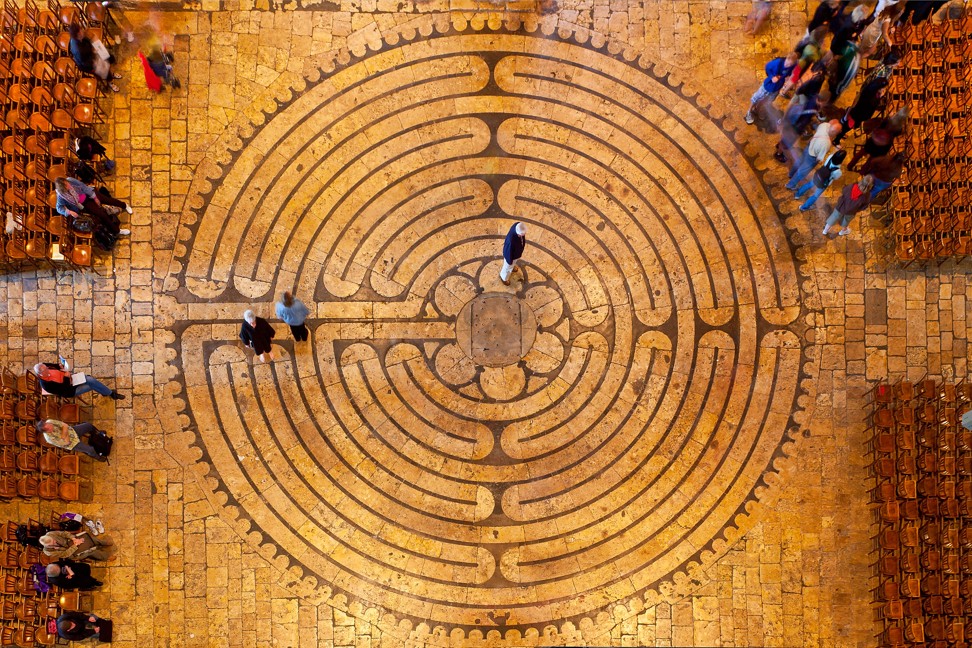
How to relax amid Hong Kong’s troubled times: walk a meditation labyrinth and find your centre
- As tensions run high in Hong Kong, a powerful relaxation device at the Star Ferry Pier has been given a facelift
- Labyrinth builder Martha Collard believes the intricate pattern offers a form of walking meditation, and experts agree
“Hong Kong needs a time out,” she says. “It needs places for rejuvenation and connection with oneself; for peace and calming. That’s what labyrinths do.”
Unlike a maze, which has dead ends, a labyrinth has only one path, and it leads to the centre. This makes the exercise a form of walking meditation.

Collard first painted the labyrinth at the pier in June 2011, as “a way to give the community an opportunity for reflection, contemplation and decompression”.
This is the third time it has been repainted. At a time when the city is wracked by a political crisis that has seen the masses hit the streets for eight consecutive weeks of demonstrations, Collard, a representative of the Labyrinth Society in Asia, says her labyrinth has never been more vital.

“When you make a labyrinth, you’re responsible for maintaining it,” she says.
Artist Maria Ng, who responded to Collard’s call to renovate the installation, says restless people can benefit from the ancient tradition.
“Many young Hongkongers don’t meditate,” she says. “It’s difficult for them to sit down and do something quiet like a silent meditation. Doing something like this can easily get them into that no-thinking state.”

Labyrinths have been around for more than 6,000 years in different cultures. They are found at medieval Christian places of worship, such as Chartres Cathedral in France, where a labyrinth was installed in the 13th century for the benefit of pilgrims. In Native American culture, the “Man in the Maze”, depicting a figure at the entrance to a pattern of seven circles, was a common design used by the Tohono O’Odham people.
Other variations of the labyrinth can be seen across Europe. The one at Pier 9 is based on the Chartres design.
The concept has been adopted as a meditation aid at venues including medical centres, religious sites, and even correctional facilities.

There are no rules covering how a labyrinth should be navigated. “When you walk, the paths are intentionally narrow to focus your attention,” says Collard. This is analogous to life’s twist and turns. “Sometimes people don’t make it to the centre; they physically can’t get there and are stuck in a spot,” she says.
Collard has observed how some people harness the lessons of the labyrinth as a tool to help them process transitions in life.
Mary Hackworth, author of Solved by Walking: Paradox and Resolution in the Labyrinth, explored the significance of labyrinth walking in the United States. The practice, her research found, allows walkers to express a desire to “walk a heroic, individual path and connect this path to a common purpose.”

In a paper published in the Journal of Jungian Scholarly Studies in 2014, Hackworth claimed that labyrinth walking allows some practitioners to better balance individual and community interests.
In the 1970s, Dr Herbert Benson, founder of Harvard Medical School’s Mind/Body Medical Institute, conducted research that found activities including meditation and labyrinth walking could elicit a relaxation response. Benson’s work suggested that this response could slow the heart rate and breathing, and reduce blood pressure.
Other researchers posit that labyrinths encourage bilateral stimulation of the brain that is reminiscent of some therapies used to treat psychological disorders, including post-traumatic stress disorder.
Collard has made indoor and outdoor labyrinths for communities in Hong Kong, including Hong Kong International School and Maggie’s Cancer Support Centre in Tuen Mun.
Falls for elderly people can be serious. How to prevent them
She has also led labyrinth walks for CancerLink. Patients find walking the labyrinth a much-needed break from the anxiety of battling a critical illness.
Jean Kan, one of the volunteers helping to repaint the Pier 9 installation, is a breast cancer survivor who walked the labyrinth four years ago at a CancerLink event.
“At first I felt stupid – it seemed aimless, following a path on the floor,” Kan, 79, recalls. “But then somehow it gained meaning – it seems to clear your mind.” The experience made Kan a convert.
A shared journey: cancer support group for English speakers
“Hong Kong is going through very troubled times; a lot of people have a lot of worries and doubts – not just young people but middle-aged people,” says the New Zealander. “We need all the tools we can to help us get a clearer mind.”
Collard says she would like to see a labyrinth on every street corner and office building in the city. “The larger goal is to thwart society’s fast track to hell in a teacup, in terms of stress,” she says. She cites various measures indicating this, including the suicide rate.
“We shouldn’t be proud we have the highest suicide rate among teenagers around the world,” she says. “We need simple, experiential practices to help people get grounded so they have a new perspective.”
Collard also points to the city’s continued slide down the world liveability index rankings as illustrative of these concerns. In a ranking of most liveable locations for Asian expatriates released in February by ECA International, Hong Kong dropped 12 places to 41st position, its lowest spot in a decade. Singapore ranked at number one.

